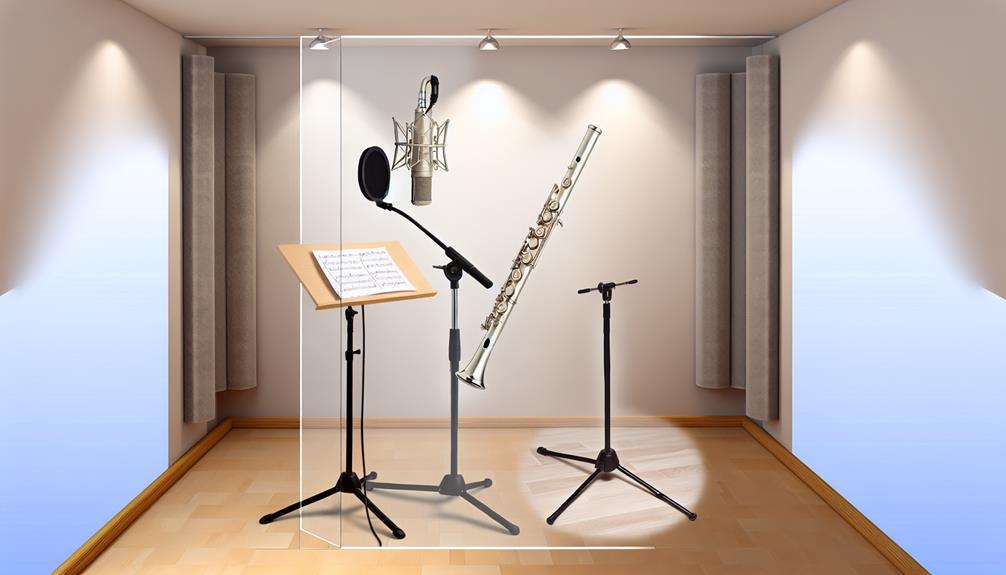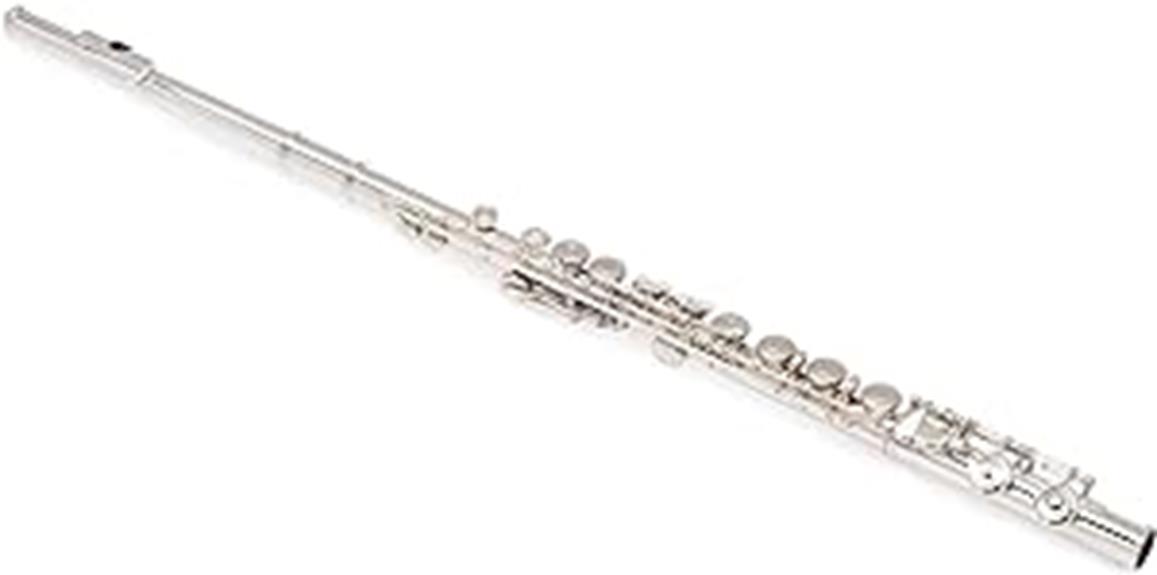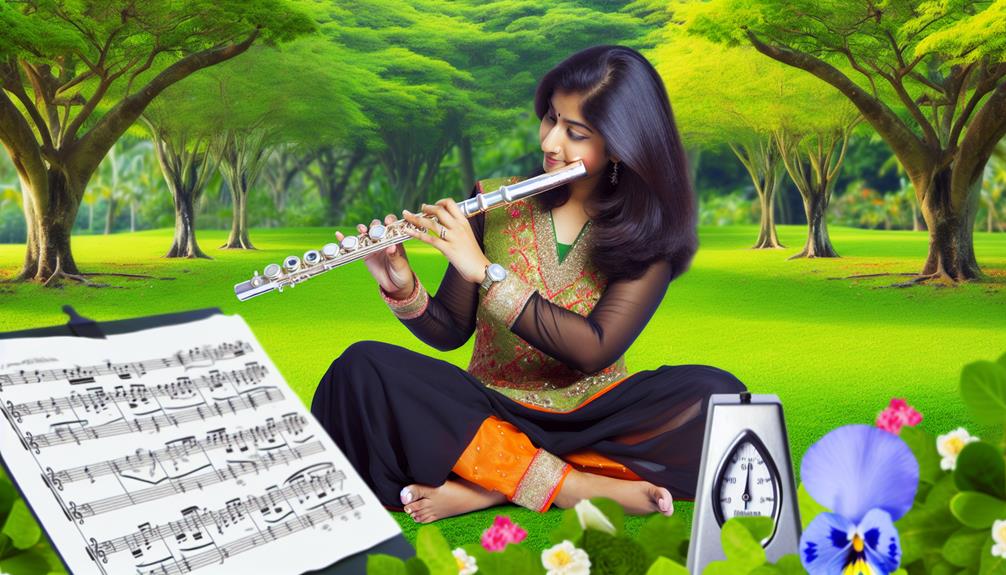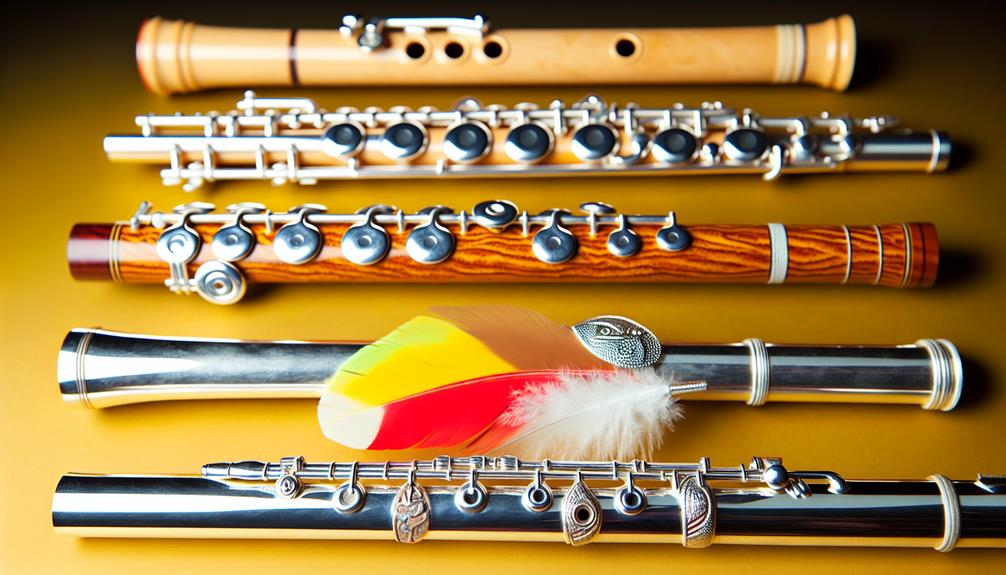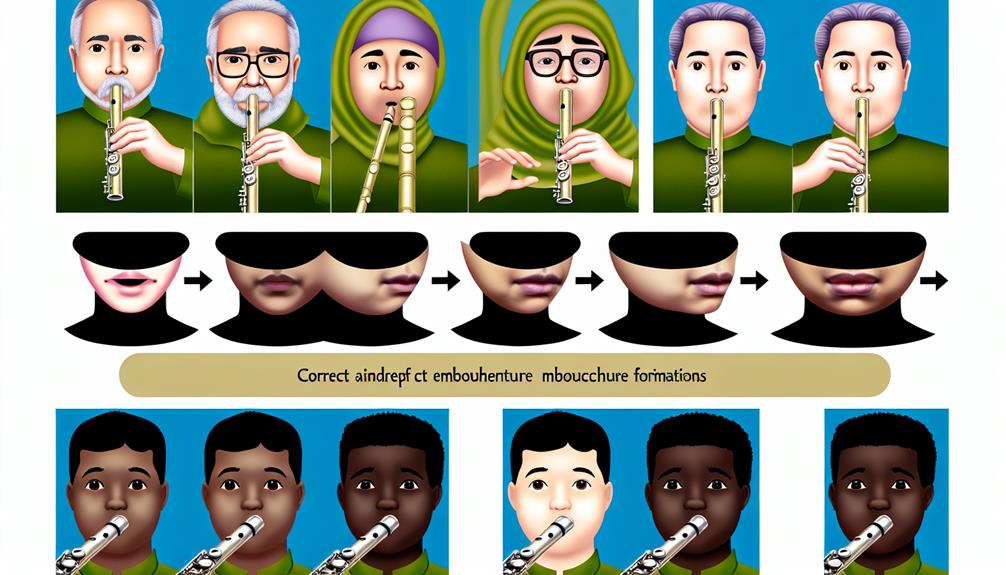Mastering the intricacies of flute embouchure is a skill that demands attention to detail and dedication. The ability to manipulate the muscles of the face and mouth to produce a clear, resonant sound is essential for any flutist looking to enhance their playing. However, achieving the perfect embouchure is not a simple task and often requires patience and practice. As we explore the nuances of embouchure techniques, we will uncover the key elements that contribute to a strong and effective embouchure, revealing the potential for improved sound quality and control in flute performance.
Key Takeaways
- Flute embouchure requires precise lip placement, airflow control, and posture for sound production.
- Developing strength and endurance in facial muscles is crucial for dynamics and tone control.
- Proper jaw alignment and consistent airflow are essential for stable embouchure formation.
- Regular practice aids in muscle memory development and technique consistency.
- Monitoring for common mistakes like incorrect lip positioning and posture helps improve performance.
Introduction
The embouchure is a fundamental aspect of flute playing. It influences tone quality, intonation, and overall musicality. In this guide, we will provide an overview of the importance of embouchure in flute performance.
We will outline the key points that will be covered to help aspiring flutists develop a strong and effective embouchure technique.
Importance of embouchure in flute playing
Embouchure, an essential aspect of flute technique, plays a pivotal role in producing a clear and resonant sound quality. Proper embouchure techniques are indispensable for flute players as they directly impact the tone and projection of the sound produced. Developing strong embouchure muscle memory is critical for achieving consistency and control in playing the flute. By practicing and refining embouchure techniques, musicians can experience benefits such as improved intonation, dynamics, and overall sound quality.
Furthermore, embouchure breath control is another key element that contributes to successful flute playing. Effective management of airflow through the embouchure hole enables players to produce a wide range of dynamics and articulations, enhancing musical expression. Developing a strong and flexible embouchure allows flutists to navigate challenging passages with ease and precision.
Overview of what will be covered in this guide
Given the essential role of embouchure in shaping the quality and control of sound production on the flute, this guide will provide an in-depth overview of key concepts and techniques essential for mastering flute embouchure. Throughout this guide, we will explore various aspects important for developing a strong and effective embouchure. From understanding different embouchure techniques and troubleshooting common issues to exploring embouchure muscle exercises and their benefits, we aim to equip you with the necessary knowledge and tools to enhance your flute playing experience. Additionally, we will discuss the significance of embouchure consistency and how it directly impacts performance effects, such as tone quality, intonation, and endurance. By focusing on these key areas, you will gain a thorough understanding of flute embouchure, enabling you to refine your skills and achieve greater proficiency in your musical endeavors.
| Embouchure Techniques | Troubleshooting |
|---|---|
| Lip Position | Air Leaks |
| Jaw Placement | Tone Production |
| Mouth Shape | Articulation Issues |
| Tongue Position | High Register Difficulty |
| Breath Support | Embouchure Fatigue |
What is Embouchure?
Embouchure, a term derived from the French word for 'mouth,' refers to the technique of shaping the lips and facial muscles to produce sound on a musical instrument. Understanding the components of embouchure, such as lip position, jaw placement, and airflow control, is vital for achieving a resonant tone and precise intonation.
While embouchure is essential for all wind and brass instruments, its specific requirements may vary depending on the instrument being played.
Definition of Embouchure
Embouchure, in the context of playing wind instruments like the flute, refers to the position and use of the lips, facial muscles, and oral cavity to produce sound.
It plays a vital role in determining the quality, tone, and control of the sound generated by the instrument.
Understanding the mechanics of embouchure is fundamental for musicians seeking to improve their playing technique and overall performance.
Explanation of embouchure
Mastering the embouchure is a crucial aspect of playing the flute. It requires precise control and coordination of facial muscles to produce the desired tone quality and pitch accuracy. Embouchure techniques, troubleshooting, exercises, and progression are essential for developing a strong embouchure.
To prevent embouchure fatigue, proper warm-ups, regular breaks, and monitoring muscle tension are important. By understanding these aspects, flutists can enhance their playing capabilities greatly.
Role of embouchure in producing sound
An essential component of flute playing, the embouchure plays a pivotal role in producing sound by controlling the airflow and shaping the tone quality. Embouchure techniques directly impact sound production and tone quality through precise lip placement and regulation of air pressure. Mastering breath control is vital for achieving a rich and resonant tone, making the embouchure a fundamental aspect of flute performance.
| Embouchure Techniques | Role in Sound Production |
|---|---|
| Lip Placement | Directly affects tone quality |
| Air Pressure | Controls airflow and volume |
Components of Embouchure
When it comes to understanding the components of embouchure, we must consider the intricate coordination of the lips, jaw, teeth, and facial muscles. Each of these elements plays an essential role in shaping the sound produced by the flute player.
Lips
An essential component of flute embouchure is the positioning and movement of the lips. Lip exercises are vital for technique improvement, enhancing lip flexibility, and strength training. Correct lip positioning is fundamental for embouchure development, ensuring ideal sound production. Engaging in specific exercises can aid in mastering the intricate coordination required for playing the flute effectively.
| Lip Exercises | Technique Improvement | Lip Flexibility |
|---|---|---|
| Strength Training | Lip Positioning | Embouchure Development |
Jaw
The role of the jaw in flute embouchure is essential for achieving proper tone production and control.
- Jaw movement, breathing techniques
- Embouchure exercises, jaw alignment
- Jaw tension, embouchure control
Jaw movement affects the airflow and shape of the oral cavity, influencing sound quality. Proper alignment and tension help in controlling pitch and dynamics. Embouchure exercises can assist in developing jaw muscles for better control and flexibility.
Teeth
Teeth play an important role in flute embouchure, contributing greatly to the formation and control of sound production. Proper teeth alignment is vital for maintaining a stable embouchure while playing the flute. Dental health is essential for overall embouchure effectiveness in flute playing.
Bite adjustment can greatly impact the sound quality produced by the flute player. Understanding the relationship between teeth and embouchure is fundamental for achieving excellent sound production.
Facial muscles
Facial muscles play a significant role in the formation and control of flute embouchure, contributing indispensably to the overall sound production capabilities of a flutist.
- Muscle engagement, Facial symmetry
- Embouchure flexibility, Lip coordination
- Muscle endurance, Jaw alignment
These aspects affect a flutist's ability to produce a consistent tone, execute dynamic changes, and achieve precision in articulation, highlighting the importance of facial muscle strength and coordination in flute playing.
Embouchure in Different Instruments
Embouchure, the shaping and control of the lips and facial muscles when playing a musical instrument, varies across different wind instruments, each requiring a unique approach to produce the desired sound.
Comparing embouchure techniques between instruments can provide insights into the nuances of playing each one effectively.
Understanding the distinct aspects of flute embouchure, such as the angle of the air stream and the positioning of the lips, is essential for mastering this instrument.
Comparison with embouchure in other wind instruments
In wind instrument performance, the technique of forming and controlling the mouth muscles and shaping the oral cavity plays a pivotal role in producing sound, with variations evident across different instruments.
- Embouchure comparison, Wind instruments
- Flute vs clarinet, Embouchure techniques
- Saxophone embouchure, Mouthpiece positioning
- Oboe embouchure, Double reed nuances
Unique aspects of flute embouchure
The flute embouchure stands out in the world of wind instrument performance due to its unique requirements and nuances compared to other instruments.
Embouchure techniques for the flute involve a delicate balance of lip placement, air direction, and mouth shape. Flute posture plays a vital role in achieving excellent sound production, requiring a straight back, relaxed shoulders, and a lifted chest.
Developing embouchure strength is essential for controlling dynamics and achieving a clear tone.
Techniques to Develop a Proper Embouchure
To develop a proper embouchure for the flute, musicians must focus on forming the initial embouchure correctly. This involves ensuring the mouth and lips are positioned in a way that allows for ideal airflow and sound production. Achieving the right angle between the flute and the lips is vital for producing a clear and resonant tone. Additionally, maintaining a consistent embouchure throughout playing ensures stability and control over the instrument's sound output.
Forming the Initial Embouchure
When developing a proper embouchure for playing the flute, it is vital to follow a step-by-step guide to guarantee correct formation.
Positioning the lips and mouth correctly is key to achieving a stable and effective embouchure.
Additionally, adjusting the aperture, or the opening between the lips, is essential for producing clear and resonant tones while playing the flute.
Step-by-step guide to forming the correct embouchure
In developing a proper embouchure for playing the flute, one must first focus on forming the initial positioning of the lips and facial muscles.
- Proper Positioning: Align lips and chin parallel to the headjoint.
- Lip Flexibility: Practice gentle lip slurs to enhance flexibility.
- Embouchure Fatigue: Be mindful of overworking facial muscles.
- Consistency: Maintain consistent airflow and lip tension for a stable embouchure.
Positioning the lips and mouth
Developing a precise embouchure for flute playing hinges on the meticulous positioning and coordination of the lips and facial muscles, particularly in aligning them parallel to the headjoint and practicing gentle lip slurs to enhance flexibility. When considering lip placement, breath control is essential for maintaining steady airflow. The angle of the mouth influences sound production, while proper jaw alignment plays a vital role in embouchure development.
| Lip Placement | Mouth Angle | Jaw Alignment |
|---|---|---|
| Breath Control | Sound Production | Embouchure Development |
Adjusting the aperture (opening)
Crafting a precise embouchure for flute playing necessitates a meticulous adjustment of the aperture.
Focusing on forming the initial embouchure with precision and control is crucial.
To achieve this, attention must be paid to lip flexibility, air control, and jaw alignment.
These factors work together to create a stable and efficient embouchure that allows for a clear tone production and improved overall performance.
Achieving the Right Angle
To develop a proper embouchure, it is essential to focus on three key points:
- Positioning the flute correctly against the lips
- Determining the best angle for directing air into the instrument
- Adjusting the head and neck to support a steady airflow
These techniques play a vital role in achieving a balanced and efficient embouchure, ensuring clear and resonant tones while playing the flute. By mastering the right angle and positioning, flutists can enhance their overall sound production and performance quality.
Proper positioning of the flute against the lips
Positioning the flute against the lips is a fundamental aspect of developing a proper embouchure, with achieving the right angle playing an essential role in producing excellent sound quality and control. To guarantee success, consider factors such as lip flexibility and air control.
Proper mouth angle contributes to maintaining a consistent sound. Incorporating embouchure exercises is paramount for skill improvement and fatigue prevention.
- Lip flexibility and air control
- Proper mouth angle for consistent sound
- Embouchure exercises for skill enhancement
- Preventing fatigue in playing
Finding the correct angle for blowing air
Developing a proper embouchure on the flute involves meticulous attention to the angle at which air is blown, a critical factor for achieving ideal sound projection and control. Proper lip angle, correct placement, and understanding flute technique are essential. Mastering airflow control and breath support are crucial for top-notch sound production. Here is a table to illustrate these key elements:
| Key Elements | Importance |
|---|---|
| Airflow control | Crucial for tone quality and dynamics |
| Correct placement | Ensures proper sound projection |
| Breath support | Essential for sustaining notes |
| Sound production | Achieved through a combination of technique and control |
Adjusting head and neck position
Achieving the ideal angle for blowing air on the flute involves precise adjustments to the head and neck position, a critical aspect in developing a proper embouchure.
- Neck alignment, breathing: Guarantee the neck is aligned with the spine to facilitate proper airflow.
- Head tilt, air support: Tilt the head slightly downwards to direct the air correctly while providing strong support.
- Posture adjustments, sound quality: Make necessary posture adjustments to enhance the quality of sound produced.
Maintaining a Consistent Embouchure
To maintain a consistent embouchure while playing the flute, it is essential to focus on tips that promote stability and control.
Monitoring and adjusting the embouchure as needed during practice sessions can help in refining and sustaining a proper technique.
Regular practice is key to developing muscle memory and ensuring that the embouchure remains consistent across various playing conditions.
Tips for consistency during play
Consistency in flute playing is essential for achieving a beautiful and controlled sound, requiring a precise and well-maintained embouchure technique.
To enhance consistency during play, focus on breath control and consistency. Additionally, prioritize maintaining tone quality and endurance.
Relaxation and focus are key elements that contribute to a steady and reliable embouchure, ultimately leading to a more consistent flute performance.
Monitoring and adjusting as needed
How can flutists effectively monitor and adjust their embouchure to maintain consistency and precision in their playing technique? Flutists can monitor progress by recording practice sessions and listening for changes in tone quality. Adjusting technique involves experimenting with lip position and air speed. Consistency in play is achieved through regular self-assessment and making small adjustments as needed.
| Monitoring Progress | Adjusting Technique | Consistency in Play |
|---|---|---|
| Record practice sessions | Experiment with lip position | Regular self-assessment |
| Listen for tone quality changes | Adjust air speed | Make small adjustments |
Importance of regular practice
Regular practice is indispensable for developing and maintaining a consistent embouchure technique in flute playing. To achieve this, players must focus on practice consistency, building embouchure stamina, and refining techniques.
A structured routine that includes daily exercises tailored to strengthen lip muscles and control airflow is vital. Consistent practice not only enhances sound quality but also promotes muscle memory for fluid and effortless performance.
Common Mistakes and How to Avoid Them
Understanding common mistakes in flute embouchure is essential for aspiring flutists. Incorrect lip positioning, blowing with incorrect intensity, maintaining poor posture, and experiencing embouchure fatigue are key areas where players often falter.
These errors can hinder tone production, range, and overall performance quality. Mastering techniques to avoid these common pitfalls is fundamental in developing a strong and reliable embouchure.
Incorrect Lip Positioning
When it comes to flute embouchure, improper lip positioning can hinder sound production and overall performance. Common mistakes include overly tight or loose lips, impacting tone quality and control.
Overly tight or loose lips
Improper lip positioning, whether overly tight or loose, can greatly impact the quality and control of sound produced while playing the flute. It affects lip flexibility, breath control, proper positioning, and consistent tone.
Additionally, it influences embouchure strength and sound quality. To achieve essential performance, it is important to maintain balanced lip pressure and positioning for a clear and resonant sound.
Fixes for improper lip placement
Common mistakes in lip positioning while playing the flute can lead to a range of issues affecting sound quality and performance consistency. Corrective techniques, such as proper alignment and technique refinement, are essential for embouchure improvement. Paying attention to lip placement and practicing specific exercises can help in achieving a more stable and effective flute playing technique.
| Common Mistakes | Corrective Techniques |
|---|---|
| Malpositioned Lips | Proper Alignment |
| Too Much Pressure | Release Tension |
| Insufficient Support | Firm Support |
| Not Enough Coverage | Increase Coverage |
| Uneven Lip Pressure | Equalize Pressure |
Blowing Too Hard or Too Soft
The degree of air pressure exerted when playing the flute greatly influences the quality of sound produced. Blowing too hard can lead to a harsh tone, while blowing too softly may result in a weak and airy sound.
Employing techniques such as proper breath support and embouchure control can help flutists effectively manage and adjust their air flow for best sound production.
Impact of air pressure on sound quality
Maintaining ideal air pressure when playing the flute is essential for achieving a balanced and resonant sound quality. When considering the impact of air pressure on sound, it is important to focus on:
- Air pressure techniques, sound modification
- Breath control, tone adjustment
- Embouchure flexibility, sound refinement
- Avoiding extremes of blowing too hard or too soft
Techniques to control air flow
Control over air flow is a fundamental aspect of mastering flute playing.
Particular attention is needed to avoid the common mistakes of blowing too hard or too soft.
Proper air flow control, supported by effective breath support, is essential for achieving ideal tone production and sound quality.
Developing embouchure flexibility and endurance through balanced air pressure is vital for a well-rounded flute performance.
Poor Posture and Its Effects
Maintaining proper posture is essential for achieving excellent flute embouchure. Poor posture can have a detrimental effect on the quality of sound produced and impede overall performance.
Implementing specific exercises can help correct posture issues and enhance playing technique.
Importance of maintaining good posture
Good posture is essential for flute players to achieve excellent breath control and produce a clear, resonant tone.
- Posture benefits: Enhances embouchure techniques
- Alignment importance: Establishes a strong embouchure connection
- Body awareness: Improves embouchure control
- Supportive stance: Facilitates ideal airflow and tone production
How poor posture affects embouchure
Poor posture can greatly impact a flutist's embouchure, leading to difficulties in breath control and tone production. Body alignment plays a vital role in achieving excellent sound quality.
Improper posture can result in embouchure fatigue, limiting a musician's performance longevity. Posture correction is essential to prevent these issues and maintain a healthy embouchure for consistent and high-quality flute playing.
Exercises to correct posture
Implementing targeted exercises that focus on strengthening core muscles and improving spinal alignment can effectively correct poor posture in flutists, enhancing their overall performance and embouchure control.
- Posture correction: Specific exercises like Pilates or yoga can help in aligning the spine correctly.
- Alignment techniques: Utilizing mirrors to check alignment during practice sessions.
- Muscle engagement: Engaging core muscles while playing to support proper posture.
- Embouchure fatigue: Taking regular breaks and stretching to prevent muscle strain.
Embouchure Fatigue
Embouchure fatigue is a common issue among flute players that can hinder performance and lead to potential injuries. Recognizing the signs of embouchure fatigue is important, as is implementing strategies to prevent and manage it effectively.
Taking regular breaks during practice sessions is essential for maintaining a healthy embouchure and overall playing technique.
Signs of embouchure fatigue
Fatigue in flute embouchure can manifest through a variety of subtle yet significant signs that indicate the need for adjustments in playing technique and rest periods. These signs include:
- Decreased endurance
- Difficulty controlling pitch
- Reduced flexibility
- Sensation of tension in facial muscles
In such cases, it is important for flute players to recognize these indicators and take necessary steps to alleviate the strain on their embouchure. Regular breaks, proper hydration, and relaxation techniques can help prevent and manage fatigue, ensuring a more sustainable and enjoyable playing experience.
Tips to prevent and manage fatigue
To effectively prevent and manage fatigue in flute embouchure, musicians must prioritize proper warm-up routines, maintain consistent airflow control, and regularly assess and adjust their playing technique for peak performance.
Incorporating embouchure relaxation techniques, embouchure fatigue prevention strategies, and embouchure strengthening exercises into their practice routines can help musicians build endurance and resilience in their embouchure muscles, reducing the likelihood of fatigue during performances.
Importance of taking breaks
Properly pacing practice sessions and incorporating strategic breaks play an essential role in mitigating embouchure fatigue among flute musicians, ensuring sustained performance quality and endurance.
- Importance of rest breaks
- Benefits of a relaxation period
- Impact on performance quality
- Enhanced endurance and stamina
Exercises to Strengthen Your Embouchure
Embouchure exercises play an essential role in developing a strong foundation for flute playing. Basic exercises focus on building fundamental muscle strength and control, while advanced workouts target specific aspects like flexibility and endurance.
Basic Embouchure Exercises
Embouchure exercises play a significant role in developing a flutist's technique and tone quality. Beginners can benefit from simple drills that focus on lip flexibility and strength.
Additionally, practicing blowing exercises without the flute can help enhance breath control and embouchure stability.
Simple exercises for beginners
Regular practice of fundamental embouchure exercises is crucial for beginners to develop strength and control in their flute playing technique.
- Breathing exercises: Enhance breath support.
- Embouchure drills: Improve lip and mouth muscle coordination.
- Tone development: Focus on sound quality.
- Posture alignment: Guarantee proper body positioning for peak performance.
Lip flexibility and strength drills
Developing lip flexibility and strength through specific drills is vital for enhancing the embouchure of flute players at all skill levels.
Incorporating targeted embouchure exercises into practice routines can lead to improved tone quality and overall performance.
These exercises focus on building the muscles around the lips, which are essential for controlling airflow and producing clear, resonant sounds.
Consistent practice of these drills can help flutists achieve greater control and precision in their playing.
Blowing exercises without the flute
Strengthening the muscles involved in flute playing can be effectively achieved through blowing exercises without the use of the flute. This method focuses on enhancing the embouchure's control and flexibility.
- Breath control, relaxation
- Embouchure muscles, strength
- Sound production, air flow
Advanced Embouchure Workouts
In the domain of advanced flute playing, embouchure workouts that cater to seasoned musicians become paramount. These exercises typically involve long-tone practices to enhance endurance and control over the instrument.
Additionally, focusing on dynamics and articulation aids in refining the nuances of sound production and musical expression at an advanced level.
Exercises for more experienced players
Advanced players looking to enhance their flute embouchure should engage in a series of challenging exercises designed to further refine their control and precision. These exercises focus on:
- Implementing advanced techniques and breath control
- Enhancing tone quality through specific articulation exercises
- Building performance readiness through targeted endurance training.
Long-tone exercises
Long-tone exercises are essential for advanced players seeking to enhance the strength and control of their flute embouchure.
These exercises focus on breath control, endurance, tone quality, and intonation.
By sustaining notes for extended periods, flute players can refine their embouchure muscles, leading to improved articulation and dynamics.
Consistent practice of long-tone exercises is important for developing a solid foundation in advanced embouchure techniques.
Dynamics and articulation practice
Diving into exercises that focus on dynamics and articulation is a pivotal step for advanced flute players looking to further strengthen their embouchure muscles and enhance their overall playing technique.
- Embouchure dynamics, tone control
- Articulation precision, breath support
- Performance expression, musical interpretation
Incorporating Embouchure Practice into Daily Routine
To effectively strengthen your embouchure, incorporating daily practice routines is essential. By following tips for consistent practice, setting achievable goals, and tracking your progress, you can enhance your embouchure strength and control.
These exercises will not only improve your flute playing but also help you develop a solid foundation for advanced techniques.
Tips for daily practice
Incorporating daily embouchure exercises into your practice routine is essential for strengthening the muscles used in flute playing and improving overall tone production.
- Breathing exercises, Embouchure flexibility
- Tone production, Articulation techniques
- Warm up routines, Daily consistency
- Regular breaks, Proper hydration
Consistent practice of these exercises will enhance your flute playing abilities and contribute to your musical growth.
Setting realistic goals
Developing attainable objectives is essential in enhancing your flute playing skills through consistent practice of embouchure exercises. Setting goals that are challenging yet achievable, such as increasing endurance or improving tone quality, can help you progress effectively.
Tracking progress by keeping a practice journal and celebrating small milestones will keep you motivated. By setting realistic goals, you can maintain focus and see steady improvement in your flute playing abilities.
Tracking progress and improvements
Progress tracking and improvement assessment are integral components of enhancing flute playing skills, particularly when incorporating dedicated embouchure practice into your daily routine.
- Tracking Progress: Keep a practice journal to note daily achievements.
- Measuring Improvements: Record yourself playing to compare and identify areas of growth.
- Evaluating Techniques: Seek feedback from instructors or peers to refine your embouchure methods.
- Setting Benchmarks: Establish specific goals to work towards during practice sessions.
Conclusion
To sum up, it is essential to recap the key points discussed in this article on flute embouchure.
Additionally, regular and mindful practice is encouraged to strengthen your embouchure technique effectively.
Recap of key points
To summarize the essential elements of flute embouchure, it is important to review the key points discussed throughout the detailed analysis in order to grasp a thorough understanding of this important technique.
- Embouchure techniques, advanced players: Advanced players should focus on refining their embouchure techniques, ensuring a stable and consistent airflow for best performance.
- Embouchure fatigue, prevention tips: To prevent embouchure fatigue, musicians must practice proper breath control, take breaks during extended playing sessions, and maintain good oral hygiene to support embouchure health.
- Lip flexibility, strength drills: Developing lip flexibility is important for achieving a wide range of tones. Regularly practicing strength drills, such as long tones and lip slurs, can enhance lip flexibility and overall embouchure control.
- Consistent practice regimen: Establishing a consistent practice regimen that incorporates warm-up exercises, scales, and etudes is essential for maintaining and improving flute embouchure skills over time.
Encouragement to practice regularly and mindfully
Given the intricate nature of flute embouchure and its significant impact on overall performance quality, consistent and mindful practice is strongly encouraged to nurture and refine this fundamental technique. Breath control and mindfulness play important roles in developing a strong embouchure. Practicing regularly not only improves breath support but also enhances focus and concentration, essential for mastering this intricate art. Motivation is key to sustaining a consistent practice routine. Setting achievable goals and celebrating progress can help maintain enthusiasm and commitment.
Embouchure relaxation is essential to prevent tension and promote endurance. Mindful practice can aid in identifying and releasing unnecessary tension in facial muscles, allowing for a more relaxed and efficient embouchure. Muscle memory is developed through repetitive and deliberate practice. Consistency in practicing correct techniques helps solidify muscle memory, making it easier to reproduce desired sounds effortlessly.
Next steps for further development
Moving forward in the pursuit of mastering flute embouchure, a strategic approach to further development is essential for refining skills and achieving technical proficiency.
To continue enhancing embouchure abilities, individuals can explore advanced techniques that challenge their current skill level, pushing boundaries and expanding their capabilities.
It is also important to focus on building embouchure stamina through targeted endurance training, gradually increasing playing time and intensity to strengthen the muscles involved in producing sound.
Additionally, incorporating practices that promote embouchure relaxation is vital in releasing tension that may hinder performance quality. Techniques such as mindfulness exercises, gentle stretching routines, and regular breaks during practice sessions can aid in tension release, allowing for a more fluid and controlled embouchure.
Frequently Asked Questions
How Does Embouchure Affect Tone Quality?
The embouchure plays a vital role in shaping the tone quality produced by a flute player. Factors such as air support, lip position, tongue placement, jaw tension, mouth shape, and throat opening all contribute to the overall sound. Proper technique and control of these elements can result in a rich, resonant tone, while incorrect or inconsistent embouchure can lead to a weaker, less focused sound.
Mastering these aspects is essential for achieving a desired tone quality.
Is Embouchure the Same for All Types of Flutes?
Embouchure techniques can vary greatly across different flute types. The nuances in embouchure for instruments like the concert flute, piccolo, or alto flute are influenced by factors such as size, shape, and blowing angle.
While certain basic principles of breath control may apply universally, adapting one's embouchure to suit the specific requirements of each flute type is essential for achieving excellent tone quality and performance proficiency.
Can Braces or Dental Work Affect Embouchure?
Braces can impact embouchure technique by altering the alignment of the teeth and affecting the position of the lips and jaw. Dental work may require adjustments to maintain proper embouchure, as changes in oral structure can influence airflow and tone production. Strengthening lip muscles is important for adapting to these changes, ensuring stability and consistency in flute playing.
Professional guidance and practice can help musicians navigate these challenges and optimize their embouchure for best performance.
How Often Should Embouchure Be Reassessed?
Embouchure flexibility, muscle memory, and endurance are key factors in maintaining peak flute playing. Reevaluating embouchure should be done regularly to guarantee proper technique and prevent issues arising from muscle fatigue or changes.
Frequency of reassessment may vary depending on individual practice habits and performance demands. Consistent practice and awareness of any changes in sound production can guide the musician in determining when it is necessary to reassess and refine their embouchure.
Are There Specific Dietary Recommendations for Improving Embouchure?
Nutrition tips, exercise routine, and hydration importance play significant roles in enhancing embouchure strength and endurance.
A balanced diet rich in fruits, vegetables, lean proteins, and whole grains can provide essential nutrients for muscle health.
Incorporating exercises targeting facial muscles can improve embouchure control.
Staying hydrated is essential for peak muscle function.
Conclusion
To sum up, mastering flute embouchure is essential for achieving sound quality and control on the flute. By focusing on proper technique, consistent airflow, and exercises to strengthen the embouchure, flutists can enhance their overall performance.
One common objection may be the time and effort required to develop a proper embouchure, but the benefits of improved sound production and tone control are well worth the investment in practice and technique refinement.

